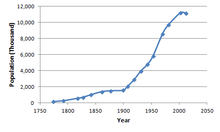Demographics of Cuba

Scatter plot of the population of Cuba (in thousands), 1774–2012
|
|
| Population | 11,167,325 (2012) 11,210,064 (2013) 11,238,317 (2014) 11,239,004 (2015) |
|---|---|
| Density | 264 per squ. mile/ 102 per squ. km (2012 est.) |
| Growth rate | -0.1% (2002–12) |
| Birth rate | 9.92 births/1,000 inhabitants (2013 est.) |
| Death rate | 7.58 deaths/1,000 inhabitants(2013 est.) |
| Life expectancy | 78.0 years (2013 est.) |
| • male | 75.8 years (2013 est.) |
| • female | 80.4 years (2013 est.) |
| Fertility rate | 1.75 children/women (2013 est.) |
| Infant mortality rate | 4.76 deaths/1000 live births (2013 est.) |
| 0–14 years | 16.6% (2013 est.) |
| 15–64 years | 71.1% (2013 est.) |
| 65 and over | 12.3% (2013 est.) |
| Total | 0.99 (2013 est.) |
| At birth | 1.06 (2013 est.) |
| Under 15 | 1.06 (2013 est.) |
| 15–64 years | 1.01 (2013 est.) |
| 65 and over | 0.82 (2013 est.) |
| Nationality | Cuban |
| Major ethnic | White (64.1%) (2012) |
| Minor ethnic | Mulatto or mestizo (26.6%), black (9.3%) (2012) |
| Official | Spanish |
The demographic characteristics of Cuba are known through census which have been conducted and analyzed by different bureaus since 1774. The National Office of Statistics of Cuba (ONE) since 1953. The most recent census was conducted in September 2012. The population of Cuba at the 2012 census was 11.1 million. The population density is 100.7 inhabitants per square kilometer, and the overall life expectancy in Cuba is 78.0 years. The population has always increased from one census to the next, with the exception of the 2011 census, when the count decreased by 10,000. Since 1950, Cuba's birth rate has surpassed its death rate; the natural growth rate of the country is positive. Cuba is in the fourth stage of demographic transition. In terms of age structure, the population is dominated (71.1%) by the 15- to 64-year-old segment. The median age of the population is 39.5, and the gender ratio of the total population is 0.99 males per female.
Cuba is inhabited mostly by whites (64.1%), while minorities include mulatto or mestizo (26.6%) and black (9.3%).
According to the 2002 census, Cuba's population was 11,177,743, whereas the 2012 census numbered the population at 11,167,325. The drop between the 2002 and 2012 censuses was the first drop in Cuba's population since Cuba's war of independence. This drop was due to low fertility and emigration, as during this time (fiscal years 2003-2012), 332,028 Cubans received legal permanent residence in the United States.
See Also List of cities in Cuba
Nº, City, Population, Province
Structure of the population :
Structure of the population (01.07.2013) (Estimates):
The 2002 census figures supplied by the government claim that 65% of Cubans were white.
The ancestry of Cubans comes from many sources:
During the 18th, 19th and early part of the 20th century, large waves of Spanish immigrants from Canary Islands, Catalonia, Andalusia, Galicia, and Asturias emigrated to Cuba. Between 1882 and 1898, a total of 508,455 people left Spain, and more than 750,000 Spanish immigrants left for Cuba between 1899 and 1923, with many returning to Spain.
...
Wikipedia
